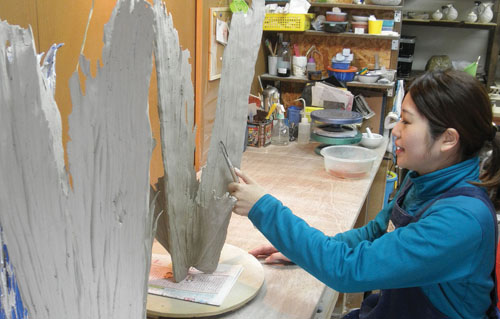Hashimoto Machiko

by Robert Yellin
|
If you could see a color representing the flow of time, what color would you see? Kyoto ceramic artist Hashimoto Machiko sees the color blue, vividly. In all of her highly original ceramic sculptures and vessels for daily use there is only one color— other than the white of the half porcelain, half stoneware body she uses— that you can see and that is, as you guessed, blue. Dark, haunting blues and billowing powder blues impart a soothing tonal quality to her razor-edged creations. At her 2011 Takashimaya Kyoto exhibition she titled the entire body of work “Time of Blue” and not as you might think in an emotional “I feel blue” context, but in an uplifting, rejoicing of life itself. She wanted to show the world her vision of how time flows, like water that flows in rivers and streams to the deep blue ocean. Blue: Miles Davis, Joni Mitchell, and now Hashimoto. Her work is a jazzy thing too. More than water, it is flowers and the precise moment of blooming that Hashimoto wants to represent in her works, mostly on her larger sculptural forms. You can sense the immediate tension and release, in an instant, of how petals open freely to the sky, each fragile and yet firm. The edges of the larger works here also hint at the same fragility, but in fact her high-firing gives them a density and solidness that keeps the petals frozen in time. Hashimoto was first attracted to clay in elementary school when on a field trip to Nagoya she decided to make not a tea bowl, but of all things, a ramen bowl. That moment was all she needed—focused young woman she was—to know that somehow she had to make it a career, though fortunately for the yakimono world not in the ramen trade. After graduating from the art department of Kyoto Saga Art Junior College in 2009, where she was awarded at the graduation exhibition held at the Kyoto City Museum of Art, she set up studio in her hometown of Kyoto. Hashimoto works out of her house in a residential area of Kyoto where she and her husband share two kilns set on the outside porch. Occasionally a stray cat comes by for food and to inspect the work. It hasn’t been all that easy though, as any artist can attest, in creating one’s own voice. For those familiar with the Japanese ceramic scene, Hashimoto’s works are instantly recognizable as hers, even down to simpler vessels meant for daily use. In a land where pottery has been part of the cultural landscape for centuries, that is no easy feat. In my eyes, and I imagine in Hashimoto’s eye’s as well, this is only the beginning– as it should be, considering she’s only twenty-something. Her path has only just begun to open. In the future she hopes to make works that amaze viewers for their originality, technique and form. Just as important are their connections to the natural world. Whether someone sees a flower, coral, flowing water or the boundless sky in Hashimoto’s work, it really doesn’t matter, as long as there is a connection between that which is viewed and those who are viewing it. When that satori-like moment of non-separateness occurs, then there is a spiritual bond, and that must happen for art to have profound meaning. “I am what I see, what is there is me, look at that incredible flower, it’s born from a seed, blooms and dies just like I do, there is no difference between that flower (nature) and my being.” This is the story that Hashimoto’s works are longing to tell you. Watch with a silent mind as the beauty of her work blossoms in front of you. It’s all there, in blue. |
時間の流れを色で表現するとしたらあなたはどんな色で表現するだろう?京都在住の陶芸家、橋本満智子は時間の流れを鮮やかなブルーで表現している。実際に日用品としても使える彼女の独創的な作品は、素地の白い部分以外は、まるでその色の持つ魔力に取りつかれたかのように、ブルーしか使っていない。印象的な深いブルーや波を思わせるような淡いブルーはどれもうっとりするような色合いで、作品の質を高めている。2011年に京都高島屋で開催された彼女の個展は“Time of Blue”とタイトルが付けられていた。それは「ブルーな気持ち」のブルーではなく、ブルーという色が持つ明るいイメージによって、深く青い海に注ぐ川の流れを思わせるような「時間の流れ」をテーマに、彼女独自のセンスで表現した個展だった。マイルス・デイヴィスやジョニ・ミッチェルがブルーをモチーフにして作品を発表したように、ブルーにこだわった橋本の作品もどこかジャズに相通ずるところがある。 彼女が特に大きな彫刻的作品のモデルにしているのはしかし水の流れではなく花、しかも開花の瞬間である。一つ一つの花弁が儚くも力強く空に向かって自由に花開く様が緊張感と開放感を持って生き生きと伝わってくる。作品の輪郭に儚さを漂わせながらも、高温焼成法によって濃密で堅い仕上がりとなり、花弁が時間の中で凍結したような印象も与えている。 橋本が初めて陶芸に興味を抱いたのは小学生の時だという。名古屋での校外学習で焼き物作りを体験したのだが、その時彼女が作ったのは茶碗などではなく何とラーメンどんぶりだった。その時に焼き物の魅力を知り、彼女のその後の進む道が決まった。2009年に京都嵯峨芸術大学短期大学部専攻科美術専攻を卒業し、生まれ故郷の京都に自身のアトリエを開いた。なお彼女は同年に京都市美術館で開かれた同大学卒業制作展で専攻科賞を受賞している。現在彼女は京都の住宅街にある自宅を仕事場にしていて、そこでは屋外のポーチに二つの窯を設置してご主人と共同で使っている。時には野良猫がエサを求めてやってきて彼女たちの仕事をじっと見ていたりすることもあるそうだ。 もちろん苦労もあった。どんなアーティストでも独自のスタイルを確立するのは簡単なことではない。日本の陶芸品に通じている人なら橋本の作品は例えそれが実用的な器の類であっても一目見ただけで彼女の作品と判るだろう。陶芸が昔から文化の一部であった日本で彼女ほどの独創性を発揮できることは並大抵のことではない。しかしなんといってもまだ20代の若さ。彼女のキャリアはまだ始まったばかりだ。彼女自身もそう感じているだろう。 将来的な希望としてはオリジナリティーに溢れたもの、技術的に高度なもの、造形がユニークなもの、そして自然界との関わりを意識させるものを目指して作ってゆきたいという。彼女の作品を見て何を連想するだろう?花、サンゴ、水の流れ、果てしなく広がる青空・・・。しかし鑑賞者と作品の間にある種の結びつきが生まれていれば、何を連想するかは重要なことではない。鑑賞者が作品と一体化する悟りの瞬間、そこに精神的な結びつきが生まれる。そうして芸術が意味深いものとなる。「私に見えるもの、そこにあるものが私自身です。花も種から成長しやがて開花し枯れてゆく運命、私も同じです。花も含めて、自然界に生きるものと私自身の間に差はありません」。これがまさに橋本の作品が表現していることなのだ。心静かにあなた自身の確かな眼で彼女の作品が持つ美が花開く瞬間を感じて欲しい。ブルーという色に全てが表現されている。 |








